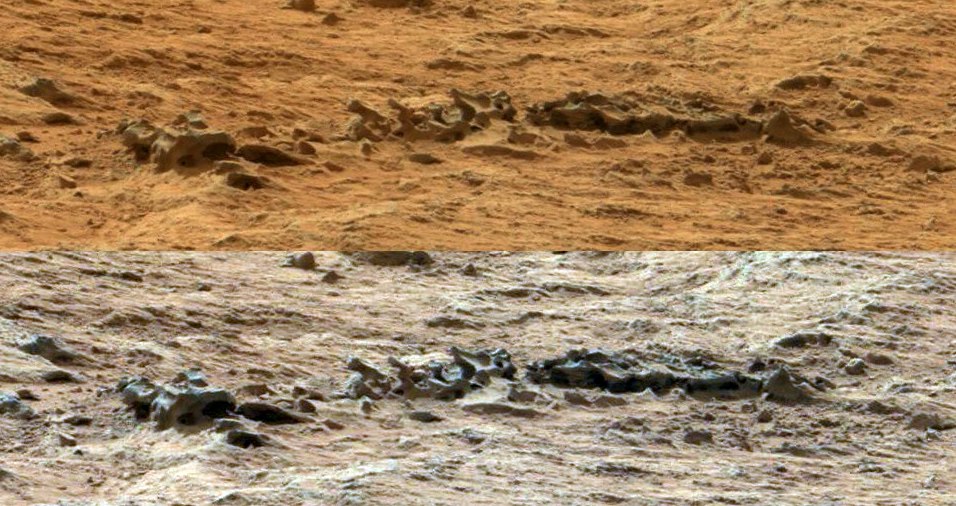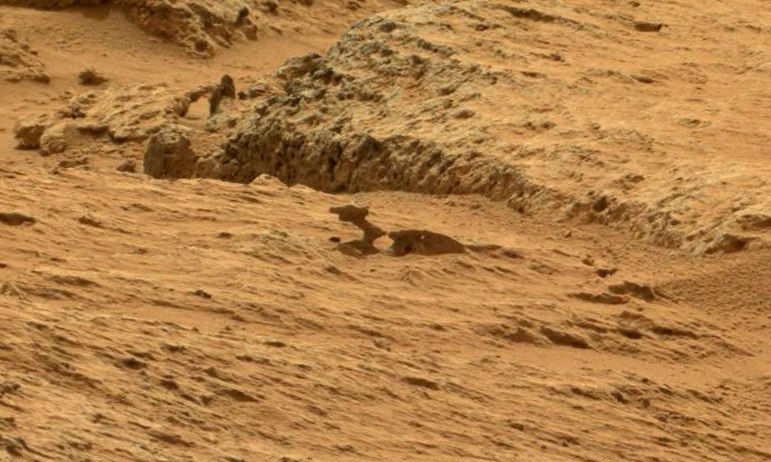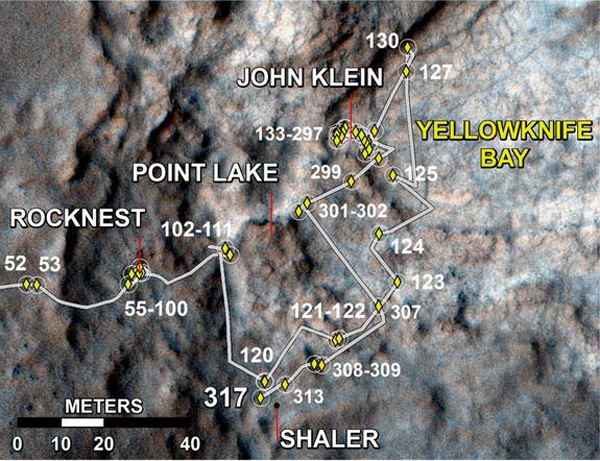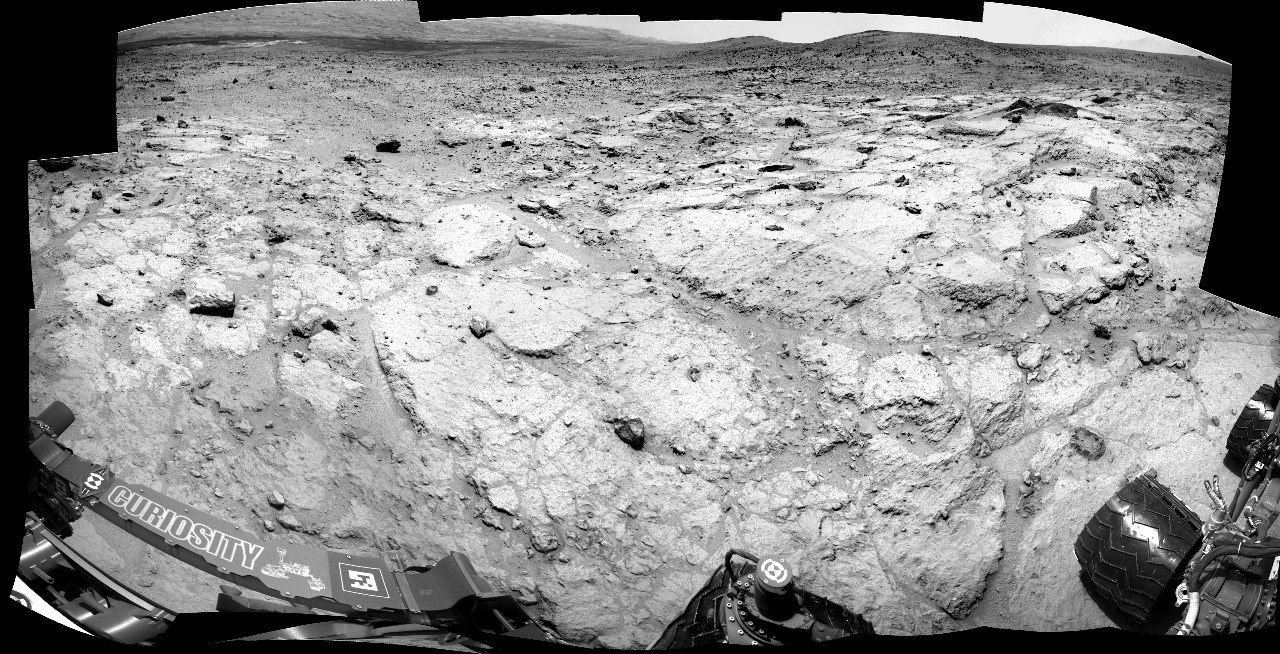681 megapixel of Mars, which almost no one saw
Not so long ago, NASA published a 1300-megapixel panorama of Mars, which Curiosity shot about 8 months ago, when it was in the place of Rocknest (rocky nest). After leaving it, the rover advanced about 20 meters and stopped for another two weeks, and again took up photography. NASA did not come up with this site names, so this panorama is nameless. In a new place, Curiosity made a circular survey, but this time did not complete 360 degrees, so the panorama turned out with small gaps and NASA did not publish it. I collected it from 392 pictures and submit it for review.

View full size panorama on the GigaPan .
Watch and download a smaller version of vk.com The
black cutout in the center of the picture is the rover itself. He shot a panorama of the 100 mm MastCam Right mast mast camera. Due to the long focal length, it cannot focus on close subjects, so they are still blurry and it makes no sense to shoot them.
Of this panorama, the most famous fragment was the “skeleton” or “ lizard spine, ” about which the media made noise in February 2013. He even managed to get into Russian Wikipedia as evidence of Martian life. True, then they realized it and “lowered” it simply to a “Curiosity photograph”.

It seems that you can’t say anything, only Martian dinosaurs can be trusted, if you do not examine the entire district. And there are a lot of such "lace". Apparently the breed contributes. So far, NASA has been evading the firm answer of what kind of rock it is: volcanic or sedimentary. But studies have already been carried out, it remains only to wait for the results. I tend to the volcanic version.
Now, in the panorama, you can catch a glimpse of all the expanses there, and see other results of the Martian wind. For example, I really like this little dragon: The

lowland in the central part of the panorama is Yellowknifle Bay, where Curiosity spent all winter and spring. There he found evidence that it was a body of water that contained water suitable for human consumption and the habitat of microorganisms. True signs of life are not found.

To better understand geography, it is useful to look at the map of the rover's movements.
The panorama was shot when it was at the point marked “102-111”.

Now Curiosity is completing a detour of this region, called Glenelg, and is located in the Shaler site, which was briefly examined on the 120th sol. Two weeks ago, the rover returned to these interesting layered sediments.

A preliminary hypothesis explaining this geology is the effect of water. On Earth, a similar rock is formed at the bottom of rivers or other bodies of water with a sandy bottom.
I recently laid out a fragment of this site .
A bit about practice.
All source photos are on the open NASA JPL server .
I use two programs for panoramas: Microsoft ICE and Kolor Autopano Giga 2.5.
ICE copes well with large canvases if they are not greatly affected by the sphericity of the lens or by differences in lighting, i.e., such as this 681-megapixel. panorama. The difference in lighting, more precisely in the exposure time, occurs when the elements of the rover fall into the frame. As a result, the camera’s automatic metering thinks that the area is better lit and reduces shutter speed. Such frames are best pulled manually before assembly. With large panoramas, ICE copes worse. For example, I collected this in parts, manually composing in Photoshop. One joint is clearly visible where the difference in lighting in the sky is visible.
Kolor Autopano Giga 2.5 copes better with sphericity and difference in lighting. But sometimes, equalizing the illumination of different parts of the frame, on the contrary, it unnecessarily highlights fragments where this is not necessary. Usually I collect black-and-white images of NavCam with this program - it handles them better. And the excess whitening of the image areas is not so critical here.

But I am, lover. If you need a professional master class on 360-degree panoramas, then contact Andrei Bodrov - he is really a guru. I already talked about a pair of his Martian works . You can try to persuade him to write about it on Habré, but I haven’t made such a request yet.
I recently went through my “archives” and found that many small Curiosity panoramas had already accumulated, which were not officially published anywhere. It will be necessary to lay them out too, only first upload to GigaPan, otherwise I don’t think that there are many enthusiasts who are ready to download pictures of 20-40 mb.

View full size panorama on the GigaPan .
Watch and download a smaller version of vk.com The
black cutout in the center of the picture is the rover itself. He shot a panorama of the 100 mm MastCam Right mast mast camera. Due to the long focal length, it cannot focus on close subjects, so they are still blurry and it makes no sense to shoot them.
Of this panorama, the most famous fragment was the “skeleton” or “ lizard spine, ” about which the media made noise in February 2013. He even managed to get into Russian Wikipedia as evidence of Martian life. True, then they realized it and “lowered” it simply to a “Curiosity photograph”.

It seems that you can’t say anything, only Martian dinosaurs can be trusted, if you do not examine the entire district. And there are a lot of such "lace". Apparently the breed contributes. So far, NASA has been evading the firm answer of what kind of rock it is: volcanic or sedimentary. But studies have already been carried out, it remains only to wait for the results. I tend to the volcanic version.
Now, in the panorama, you can catch a glimpse of all the expanses there, and see other results of the Martian wind. For example, I really like this little dragon: The

lowland in the central part of the panorama is Yellowknifle Bay, where Curiosity spent all winter and spring. There he found evidence that it was a body of water that contained water suitable for human consumption and the habitat of microorganisms. True signs of life are not found.

To better understand geography, it is useful to look at the map of the rover's movements.
The panorama was shot when it was at the point marked “102-111”.

Now Curiosity is completing a detour of this region, called Glenelg, and is located in the Shaler site, which was briefly examined on the 120th sol. Two weeks ago, the rover returned to these interesting layered sediments.

A preliminary hypothesis explaining this geology is the effect of water. On Earth, a similar rock is formed at the bottom of rivers or other bodies of water with a sandy bottom.
I recently laid out a fragment of this site .
A bit about practice.
All source photos are on the open NASA JPL server .
I use two programs for panoramas: Microsoft ICE and Kolor Autopano Giga 2.5.
ICE copes well with large canvases if they are not greatly affected by the sphericity of the lens or by differences in lighting, i.e., such as this 681-megapixel. panorama. The difference in lighting, more precisely in the exposure time, occurs when the elements of the rover fall into the frame. As a result, the camera’s automatic metering thinks that the area is better lit and reduces shutter speed. Such frames are best pulled manually before assembly. With large panoramas, ICE copes worse. For example, I collected this in parts, manually composing in Photoshop. One joint is clearly visible where the difference in lighting in the sky is visible.
Kolor Autopano Giga 2.5 copes better with sphericity and difference in lighting. But sometimes, equalizing the illumination of different parts of the frame, on the contrary, it unnecessarily highlights fragments where this is not necessary. Usually I collect black-and-white images of NavCam with this program - it handles them better. And the excess whitening of the image areas is not so critical here.

But I am, lover. If you need a professional master class on 360-degree panoramas, then contact Andrei Bodrov - he is really a guru. I already talked about a pair of his Martian works . You can try to persuade him to write about it on Habré, but I haven’t made such a request yet.
I recently went through my “archives” and found that many small Curiosity panoramas had already accumulated, which were not officially published anywhere. It will be necessary to lay them out too, only first upload to GigaPan, otherwise I don’t think that there are many enthusiasts who are ready to download pictures of 20-40 mb.
